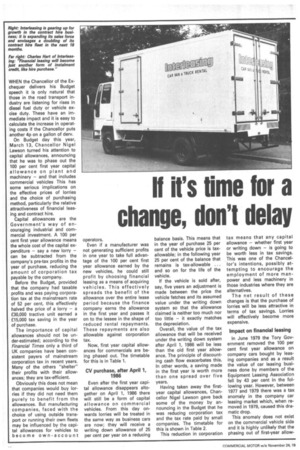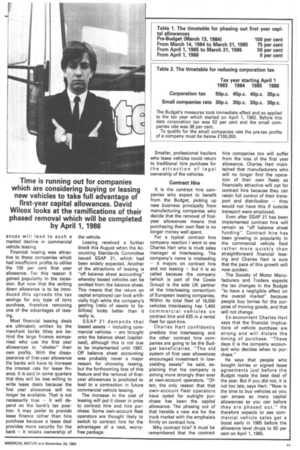lilt's time for a change, don't• delay
Page 24

Page 25

If you've noticed an error in this article please click here to report it so we can fix it.
Time is running out for companies which are considering buying or leasing new vehicles to take full advantage of first-year capital allowances. David Wilcox looks at the ramifications of their phased removal which will be completed by April 1, 1986
WHEN the Chancellor of the Exchequer delivers his Budget speech it is only natural that those in the road transport industry are listening for rises in diesel fuel duty or vehicle excise duty. These have an immediate impact and it is easy to calculate the increase in operating costs if the Chancellor puts another 4p on a gallon of derv.
On Budget day this year, March 13, Chancellor Nigel Lawson turned his attention to capital allowances, announcing that he was to phase out the 100 per cent first year capital allowance on plant and machinery — and that includes commercial vehicles This has some serious implications on the effective prices of lorries and the choice of purchasing method, particularly the relative attractiveness of financial leasing and contract hire.
Capital allowances are the Government's way of encouraging industrial and commercial investment. A 100 per cent first year allowance means the whole cost of the capital expenditure — say a new lorry — can be subtracted from the company's pre-tax profits in the year of purchase, reducing the amount of corporation tax payable by the company.
Before the Budget, provided that the company had taxable profits and was paying corporation tax at the mainstream rate of 52 per cent, this effectively halved the price of a lorry — a £30,000 tractive unit earned a £15,000 tax saving in the year of purchase.
The importance of capital allowances should not be under-estimated; according to the Financial Times only a third of UK companies have been consistent payers of mainstream corporation tax in recent years. Many of the others "shelter" their profits with their allowances; they are tax-efficient.
Obviously this does not mean that companies would buy lorries if they did not need them purely to benefit from the allowances. But manufacturing companies, faced with the choice of using outside transport or running their own fleets may be influenced by the capital allowances for vehicles to become own-account operators.
Even if a manufacturer was not generating sufficient profits in one year to take full advantage of the 100 per cent first year allowance earned by the new vehicles, he could still profit by choosing financial leasing as a means of acquiring vehicles. This effectively spreads the benefit of the allowance over the entire lease period because the finance company earns the allowance in the first year and passes it on to the lessee in the shape of reduced rental repayments. These repayments are also allowable against corporation tax.
Now, first year capital allowances for commercials are being phased out. The timetable for this is in Table 1.
CV purchase, after April 1, 1986 Even after the first year capital allowance disappears altogether on April 1, 1986 there will still be a form of capital allowance on commercial vehicles, From this day onwards lorries will be treated in the same way as business cars are now; they will receive a writing down allowance of 25 per cent per year on a reducing balance basis. This means that in the year of purchase 25 per cent of the vehicle price is taxallowable; in the following year 25 per cent of the balance that remains is tax-allowable ... and so on for the life of the vehicle.
If the vehicle is sold after, say, five years an adjustment is made between the price the vehicle fetches and its assumed value under the writing down system so that the allowance claimed is neither too much nor too little — it exactly matches the depreciation.
Overall, the value of the tax allowance that will be received under the writing down system after April 1, 1986 will be less than the old first year allowance. The principle of discounting cash flow exacerbates this. In other words, a saving made in the first year is worth more than one spread over five years.
Having taken away the firstyear capital allowances, Chancellor Nigel Lawson gave back some of the money by announcing in the Budget that he was reducing corporation tax and the tax rate paid by small companies. The timetable for this is shown in Table 2.
This reduction in corporation tax means that any capital allowance — whether first year or writing down — is going to be worth less in tax savings. This was one of the Chancellor's intentions, possibly attempting to encourage the employment of more manpower and less machinery in those industries where they are alternatives.
The net result of these changes is that the purchase of lorries will be less attractive in terms of tax savings. Lorries will effectively become more expensive.
Impact on financial leasing In June 1979 the Tory Government removed the 100 per cent first year allowance on company cars bought by leasing companies and as a result the value of car leasing business done by members of the Equipment Leasing Association fell by 43 per cent in the following year. However, between 1977 and 1979 there was a tax anomaly in the company car leasing market which, when removed in 1979, caused this dramatic drop.
This anomaly does not exist on the commercial vehicle side and it is highly unlikely that the phasing out of first-year allow ances will lead to such a marked decline in commercial vehicle leasing.
Financial leasing was attractive to those companies which had insufficient profits to utilise the 100 per cent first year allowance. For this reason it gained popularity in the recession. But now that the writing down allowance is to be introduced this spreads the tax savings for any type of lorry purchase, therefore removing one of the advantages of leasing.
Most financial leasing deals are ultimately written by the merchant banks (they are behind the large finance eompanies) who use the first year allowances to "shelter" their own profits. With the disappearance of first-year allowance the banks will have to increase the interest rate for lease finance. It is said in some quarters that they will be less willing to write lease deals because the first year allowance will no longer be available. That is not necessarily true — it will depend on the bank's tax position. It may prefer to provide lease finance rather than hire purchase because a lease deal provides more security for the bank — it retains ownership of
the vehicle.
Leasing received a further knock this August when the Accounting Standards Committee issued SSAP 21, which had been widely expected. Another of the attractions of leasing is "off balance sheet accounting" whereby leased vehicles can be omitted from the balance sheet. This means that the return on capital employed can look artificially high while the company's gearing (ratio of assets to liabilities) looks better than it really is.
SSAP 21 demands that leased assets — including commercial vehicles — are brought onto the balance sheet (capitalised), although this is not due to be implemented until 1987. Off balance sheet accounting was probably never a major reason for choosing leasing, but the forthcoming loss of this feature and the removal of firstyear allowances is predicted to lead to a contraction in future commercial vehicle leasing.
The increase in the cost of leasing will put it closer in price to contract hire and hire purchase. Some own-account fleet operators are thought likely to switch to contract hire for the advantages of a neat, worryfree package. Smaller, professional hauliers who lease vehicles could return to traditional hire purchase for the attraction of legal ownership of the vehicles.
Contract Hire
It is the contract hire cornpa flies who expect to benefit from the Budget, picking up new business principally from manufacturing companies who decide that the removal of firstyear allowances means that purchasing their own fleet is no longer money well spent.
For a typical contract hire company reaction I went to see Charles Hart who is truck sales manager at Interleasing. The company's name is misleading — it majors on contract hire and not leasing — but it is so called because the company (which is part of the Cowie Group) is the sole UK partner of the Interleasing consortium of European leasing companies. Within its total fleet of 16,000 vehicles Interleasing has 1,400 commercial vehicles on contract hire and 625 in a rental fleet for spot-hire.
Charles Hart confidently predicts that Interleasing and the other contract hire companies are going to be the Budget beneficiaries. "The old system of first year allowances encouraged investment in lowyielding assets" he said, explaining that his company is aiming more strongly than ever at own-account operators. "Often, the only reason that that own-account fleet operators have opted for outright purchase has been the capital allowance. The phasing out of that heralds a new era for the truck market with the emphaisis firmly on contract hire.
Why contract hire? It must be remembered that the contract hire companies too will suffer from the loss of the first year allowance. Charles Hart maintained that manufacturers who will no longer find the operation of their own fleets so financially attractive will opt for contract hire because they can retain full control of their transport and distribution — they would not have this if outside transport were employed.
Even after SSAP 21 has been implemented contract hire will remain as "off balance sheet funding". Contract hire has been growing in popularity in the commercial vehicle field rather more quickly than straightforward financial leasing and Charles Hart is sure that the pace of this growth will now quicken.
The Society of Motor Manufacturers and Traders expects the tax changes in the Budget "to have a negligible effect on the overall market" because people buy lorries for the purpose of moving goods, and that will not change.
Ex-accountant Charles Hart says that the financial implications of vehicle purchase are strong and will dictate the timing of purchase. "These days it is the company accountant who decides when to purchase."
He says that people who bought lorries or signed lease agreements just before the Budget made the best deal of the year. But if you did not, it is not too late, says Hart: "Now is the time to buy vehicles so you can amass as many capital allowances as you can before they are phased out." He therefore expects to see commercial vehicle sales get a boost early in 1985 before the allowance level drops to 50 per cent on April 1, 1985.
































































































